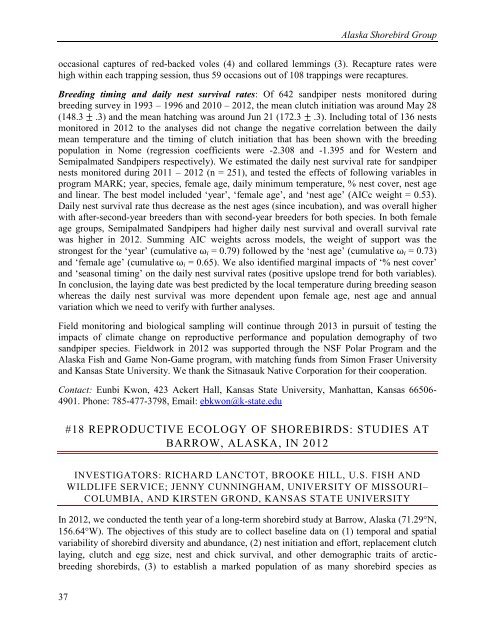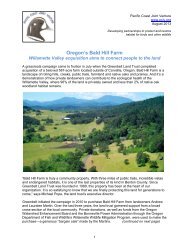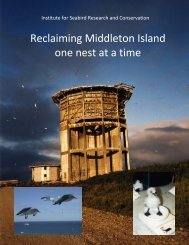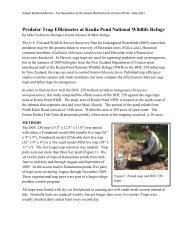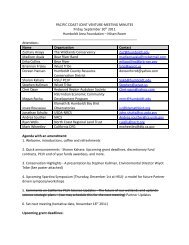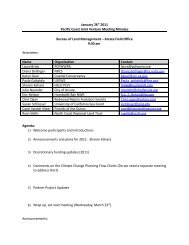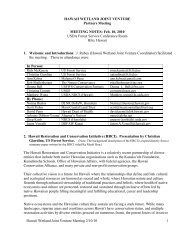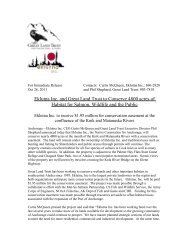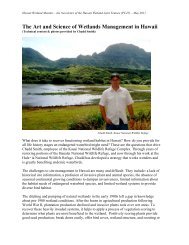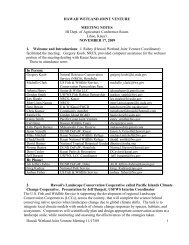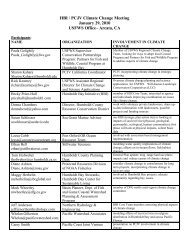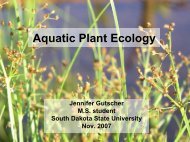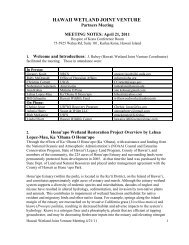Alaska Shorebird Group Annual Summary Compilation
Alaska Shorebird Group Annual Summary Compilation
Alaska Shorebird Group Annual Summary Compilation
You also want an ePaper? Increase the reach of your titles
YUMPU automatically turns print PDFs into web optimized ePapers that Google loves.
<strong>Alaska</strong> <strong>Shorebird</strong> <strong>Group</strong>occasional captures of red-backed voles (4) and collared lemmings (3). Recapture rates werehigh within each trapping session, thus 59 occasions out of 108 trappings were recaptures.Breeding timing and daily nest survival rates: Of 642 sandpiper nests monitored duringbreeding survey in 1993 – 1996 and 2010 – 2012, the mean clutch initiation was around May 28(148.3 .3) and the mean hatching was around Jun 21 (172.3 .3). Including total of 136 nestsmonitored in 2012 to the analyses did not change the negative correlation between the dailymean temperature and the timing of clutch initiation that has been shown with the breedingpopulation in Nome (regression coefficients were -2.308 and -1.395 and for Western andSemipalmated Sandpipers respectively). We estimated the daily nest survival rate for sandpipernests monitored during 2011 – 2012 (n = 251), and tested the effects of following variables inprogram MARK; year, species, female age, daily minimum temperature, % nest cover, nest ageand linear. The best model included ‘year’, ‘female age’, and ‘nest age’ (AICc weight = 0.53).Daily nest survival rate thus decrease as the nest ages (since incubation), and was overall higherwith after-second-year breeders than with second-year breeders for both species. In both femaleage groups, Semipalmated Sandpipers had higher daily nest survival and overall survival ratewas higher in 2012. Summing AIC weights across models, the weight of support was thestrongest for the ‘year’ (cumulative i = 0.79) followed by the ‘nest age’ (cumulative i = 0.73)and ‘female age’ (cumulative i = 0.65). We also identified marginal impacts of ‘% nest cover’and ‘seasonal timing’ on the daily nest survival rates (positive upslope trend for both variables).In conclusion, the laying date was best predicted by the local temperature during breeding seasonwhereas the daily nest survival was more dependent upon female age, nest age and annualvariation which we need to verify with further analyses.Field monitoring and biological sampling will continue through 2013 in pursuit of testing theimpacts of climate change on reproductive performance and population demography of twosandpiper species. Fieldwork in 2012 was supported through the NSF Polar Program and the<strong>Alaska</strong> Fish and Game Non-Game program, with matching funds from Simon Fraser Universityand Kansas State University. We thank the Sitnasauk Native Corporation for their cooperation.Contact: Eunbi Kwon, 423 Ackert Hall, Kansas State University, Manhattan, Kansas 66506-4901. Phone: 785-477-3798, Email: ebkwon@k-state.edu#18 REPRODUCTIVE ECOLOGY OF SHOREBIRDS: STUDIES ATBARROW, ALASKA, IN 2012INVESTIGATORS: RICHARD LANCTOT, BROOKE HILL, U.S. FISH ANDWILDLIFE SERVICE; JENNY CUNNINGHAM, UNIVERSITY OF MISSOURI–COLUMBIA, AND KIRSTEN GROND, KANSAS STATE UNIVERSITYIn 2012, we conducted the tenth year of a long-term shorebird study at Barrow, <strong>Alaska</strong> (71.29°N,156.64°W). The objectives of this study are to collect baseline data on (1) temporal and spatialvariability of shorebird diversity and abundance, (2) nest initiation and effort, replacement clutchlaying, clutch and egg size, nest and chick survival, and other demographic traits of arcticbreedingshorebirds, (3) to establish a marked population of as many shorebird species as37


